Survey: Nearly 1 in 4 Women Report Life-Altering Birth Control Side Effects
Nearly a quarter of women who have taken birth control say injuries or side effects have significantly impacted their lives, according to a new survey commissioned by Drugwatch. About 35% of women who have used birth control say they have experienced at least one side effect, some of which can be debilitating.
Our content is developed and backed by respected legal, medical and scientific experts. More than 30 contributors, including product liability attorneys and board-certified physicians, have reviewed our website to ensure it’s medically sound and legally accurate.
legal help when you need it most.
Drugwatch has provided people injured by harmful drugs and devices with reliable answers and experienced legal help since 2009. Brought to you by Wilson & Peterson LLP, we've pursued justice for more than 20,000 families and secured $324 million in settlements and verdicts against negligent manufacturers.
More than 30 contributors, including mass tort attorneys and board-certified doctors, have reviewed our website and added their unique perspectives to ensure you get the most updated and highest quality information.
Drugwatch.com is AACI-certified as a trusted medical content website and is produced by lawyers, a patient advocate and award-winning journalists whose affiliations include the American Bar Association and the American Medical Writers Association.
About Drugwatch.com
- 15+ Years of Advocacy
- $324 Million Recovered for Clients
- 20,000 Families Helped
- A+ BBB Rating
- 4.9 Stars from Google Reviews
Testimonials
I found Drugwatch to be very helpful with finding the right lawyers. We had the opportunity to share our story as well, so that more people can be aware of NEC. We are forever grateful for them.
- Last update: June 26, 2025
- Est. Read Time: 10 min read
Drugwatch conducted a survey to learn more about the impact of birth control on everyday life. We asked women about their birth control usage, satisfaction and side effects they have experienced.
Drugwatch is a leading resource for people seeking justice and support after being impacted by defective or dangerous products or medications. For years, Drugwatch has helped connect people with insight, research and legal resources.
Key Takeaways From Our Birth Control Survey
Drugwatch surveyed 650 women ages 18 to 70 on birth control usage and side effects.
Women reported using numerous contraceptive methods, ranging from oral pills and IUDs to injections, patches and vaginal rings.
- About 35% of women who have used birth control have experienced at least one injury or side effect.
- Roughly 23% of women who have used birth control have had their lives “greatly” or “severely” impacted by side effects and injuries.
- Of women who have switched birth control methods, 48% did so due to side effects, far outpacing all other reasons for changing.
- Only 33% of women who have used birth control have never switched methods.
Access to safe and affordable birth control plays a major role in the health and well-being of women around the globe. While some side effects are merely inconvenient, others can be significant and life-changing.
For most women who Drugwatch surveyed, birth control side effects were resolved by switching to a different method. More than three-quarters of women surveyed say that they are satisfied with their current birth control choice.
Most Commonly Used Birth Control Options
Birth control pills were the most commonly used option in Drugwatch’s survey, with nearly 74% of respondents saying that they’ve used the pill at some point. Survey participants could select multiple options to include all the forms of birth control they’ve used throughout their lives.
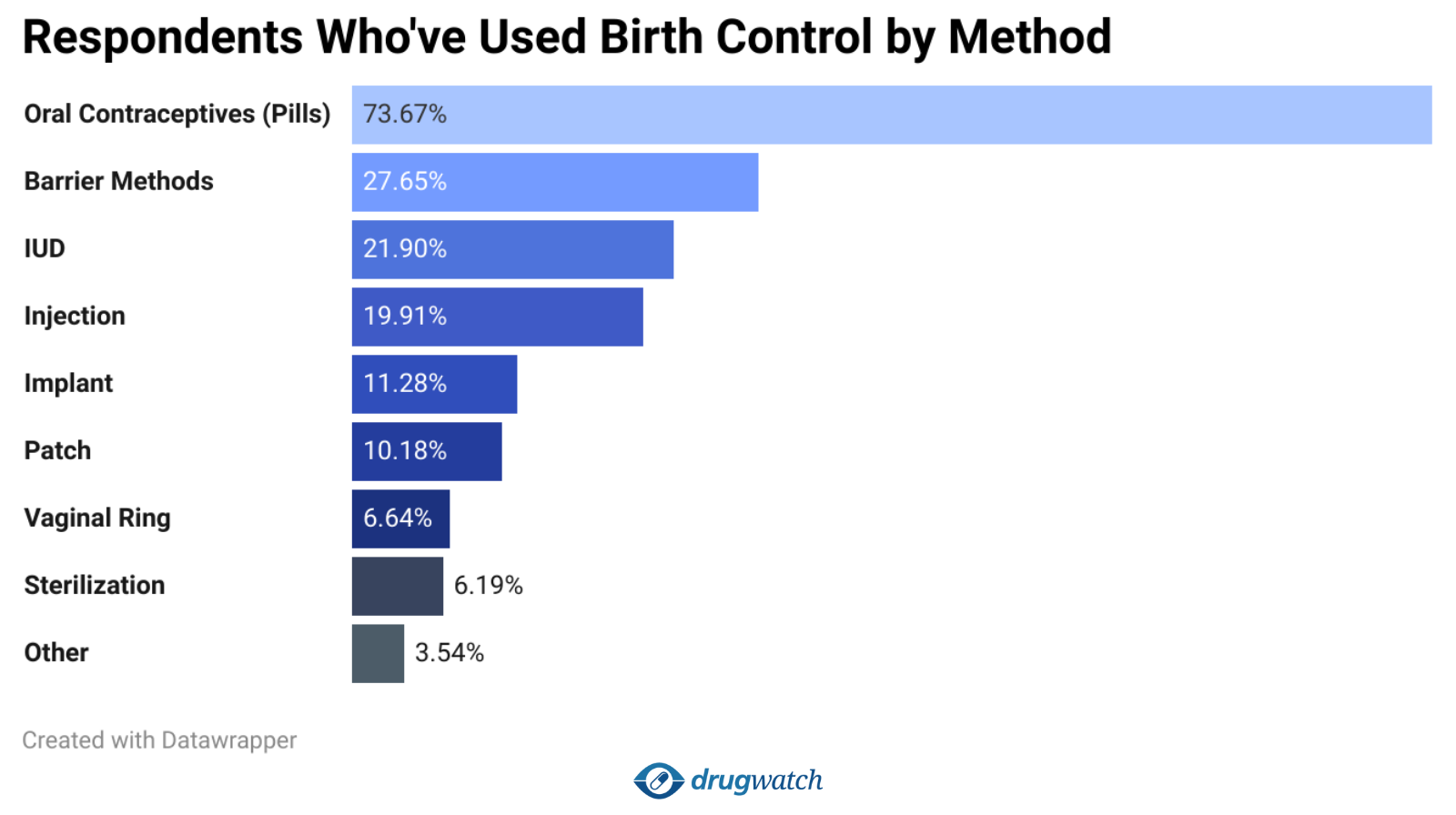
“Oral contraceptive pills are well-known, it’s relatively easy to get a prescription and start taking it, it’s patient control,” Dr. Vanessa Hux, an OBGYN, told Drugwatch.com. “They have a great variety of uses for things like acne control, menstrual regulation. They do a lot of other things.”
Barrier methods such as condoms and diaphragms were the second most popular birth control choice, with IUDs and contraceptive injections like Depo-Provera rounding out the top four.
The pill has long been one of the most popular hormonal birth control options, despite being newer than other common methods. It first became available in 1960 and quickly rose in popularity.
Modern IUDs have also been available since the early 1960s and have existed in some form since the 20th century.
Survey results show that some newer birth control methods have established a foothold as well. Birth control injections, implants, patches and vaginal rings have become widely available post-1990. Nearly half of the women from Drugwatch’s survey who used birth control reported using at least one of those options.
“The nice thing about them is that they are not a daily medication,” Dr. Hux said of newer choices like patches and vaginal rings. “The patch requires weekly action and the NuvaRing is once a month.”
More Than a Third of Birth Control Users Experience Side Effects
Side effects are common across various birth control options. Of the 452 respondents who told Drugwatch that they have used birth control, 35% say that they experienced side effects.
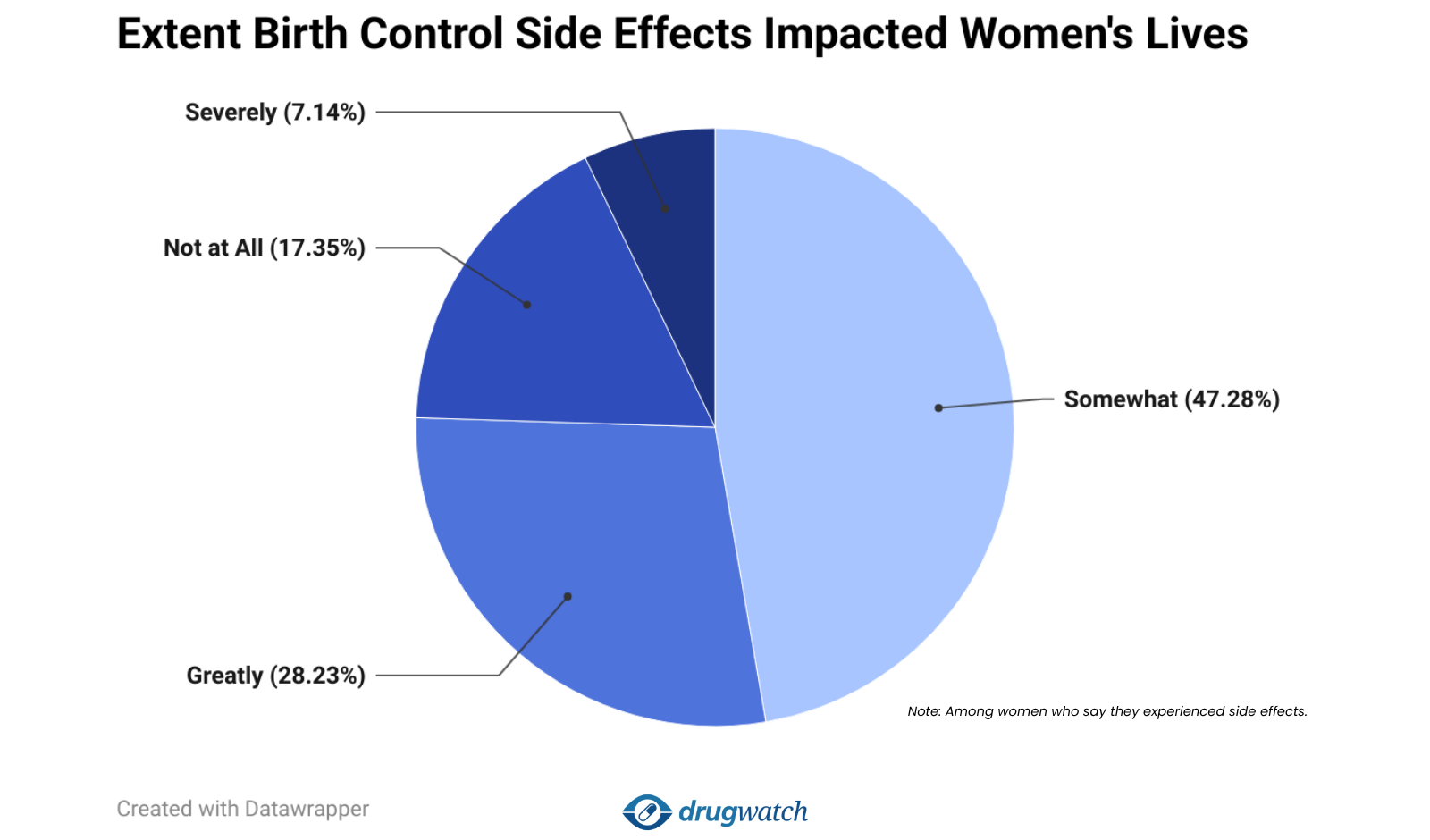
Hundreds of women reported conditions that could be considered relatively minor, such as nausea, headaches or acne.
But even side effects that may not be considered serious can still be debilitating. About 30% of women reported headaches or migraines, which have been identified as side effects of some birth control. Recurring migraines can seriously alter a person’s life.
“I had severe migraines for five years on the pill. They would last an entire week,” one woman said. “They were not regular headaches, but an insane amount of pain that would cause me to vomit. I had to call out of work and it hurt my position.”
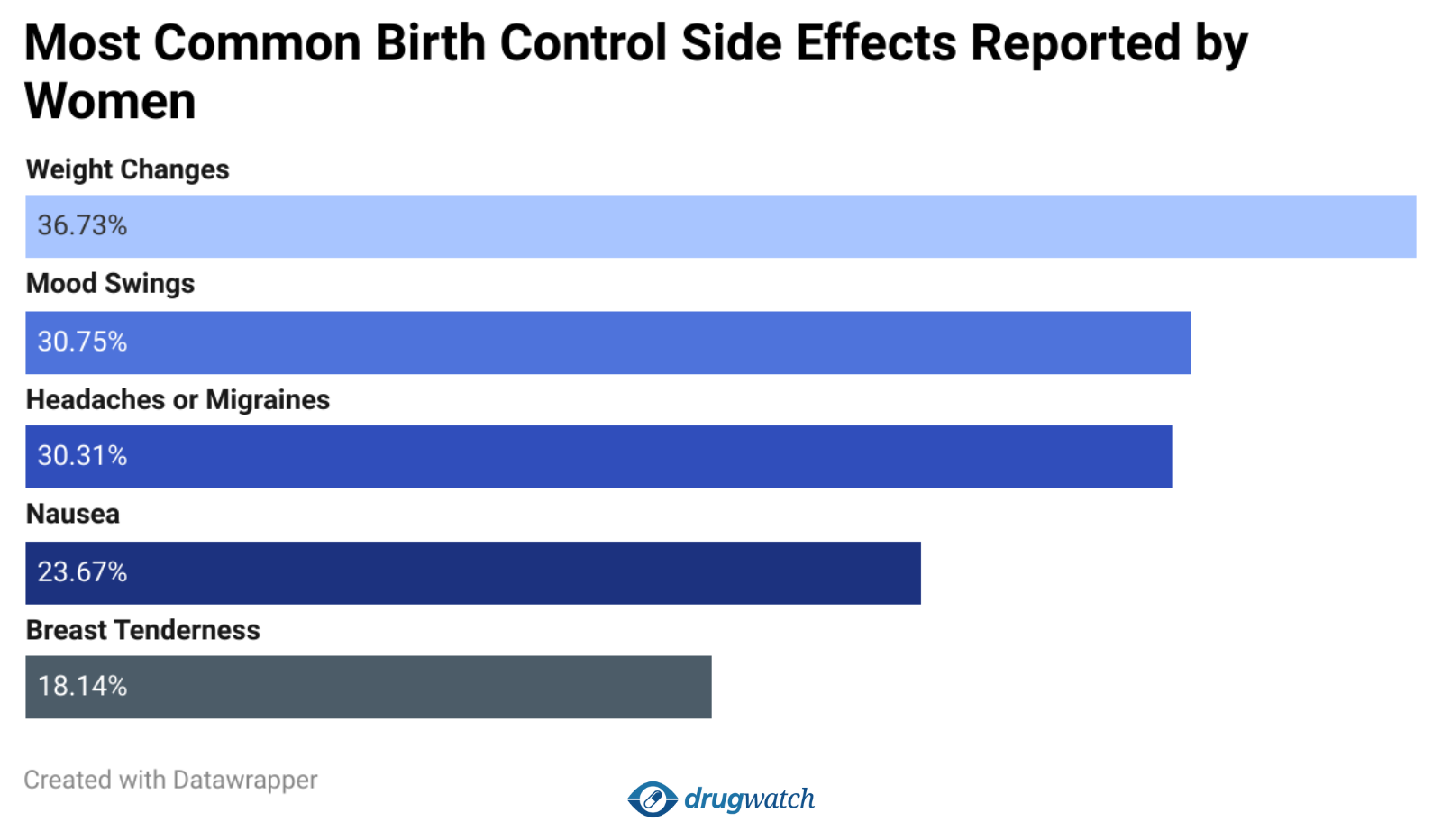
Among women who experienced side effects, more than 35% say that their lives were greatly or severely impacted. In Drugwatch’s survey, 23% of all women who said they have used birth control experienced significant side effects.
“It made day-to-day living horrible,” one respondent said. “Just getting out of bed was so traumatizing due to not feeling like myself [and] feeling like staying in bed for days.”
Weight Changes
Weight changes were reported by women across a wide range of birth control options. Women who had taken the pill were most likely to report changes in weight.
Many women who took part in this survey have taken multiple birth control options, so their reported side effects could be attributed to several different contraceptives or other factors.
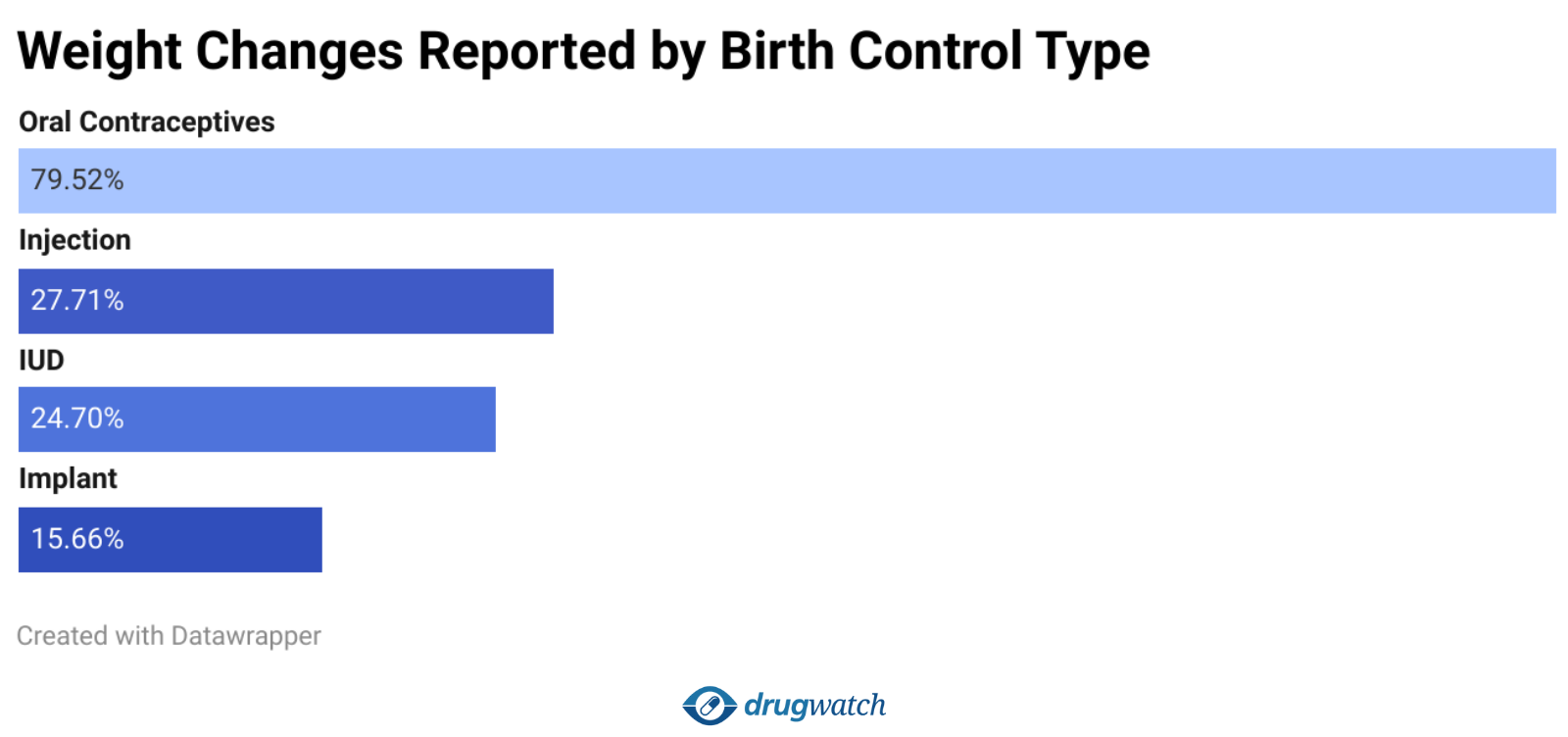
Many women who have used the pill report weight gain as a side effect, but according to Cleveland Clinic, multiple studies have shown that the pill does not lead to weight changes in either direction. Individual experiences may vary and there could be multiple contributing factors to fluctuations in weight.
“I don’t think that weight gain is necessarily a guarantee with any contraception,” Dr. Hux said.
Women who have used birth control injections at some point in their lives reported weight changes at a high rate as well. Depo-Provera has been associated with weight gain. A study published in The European Journal of Contraception & Reproductive Health Care found that women who start Depo at an earlier age gain the most weight over time.
“The contraception that has had the strongest concern about weight gain is the Depo-Provera shot,” Dr. Hux said. “Anecdotally, I see that sometimes in patients. But I have also a lot of patients that are normal weight [or] BMI that tolerate it great and they love it.”
Mood Swings
Among women who reported mood swings as a birth control side effect, the pill, IUDs and injections were the most popular choices.
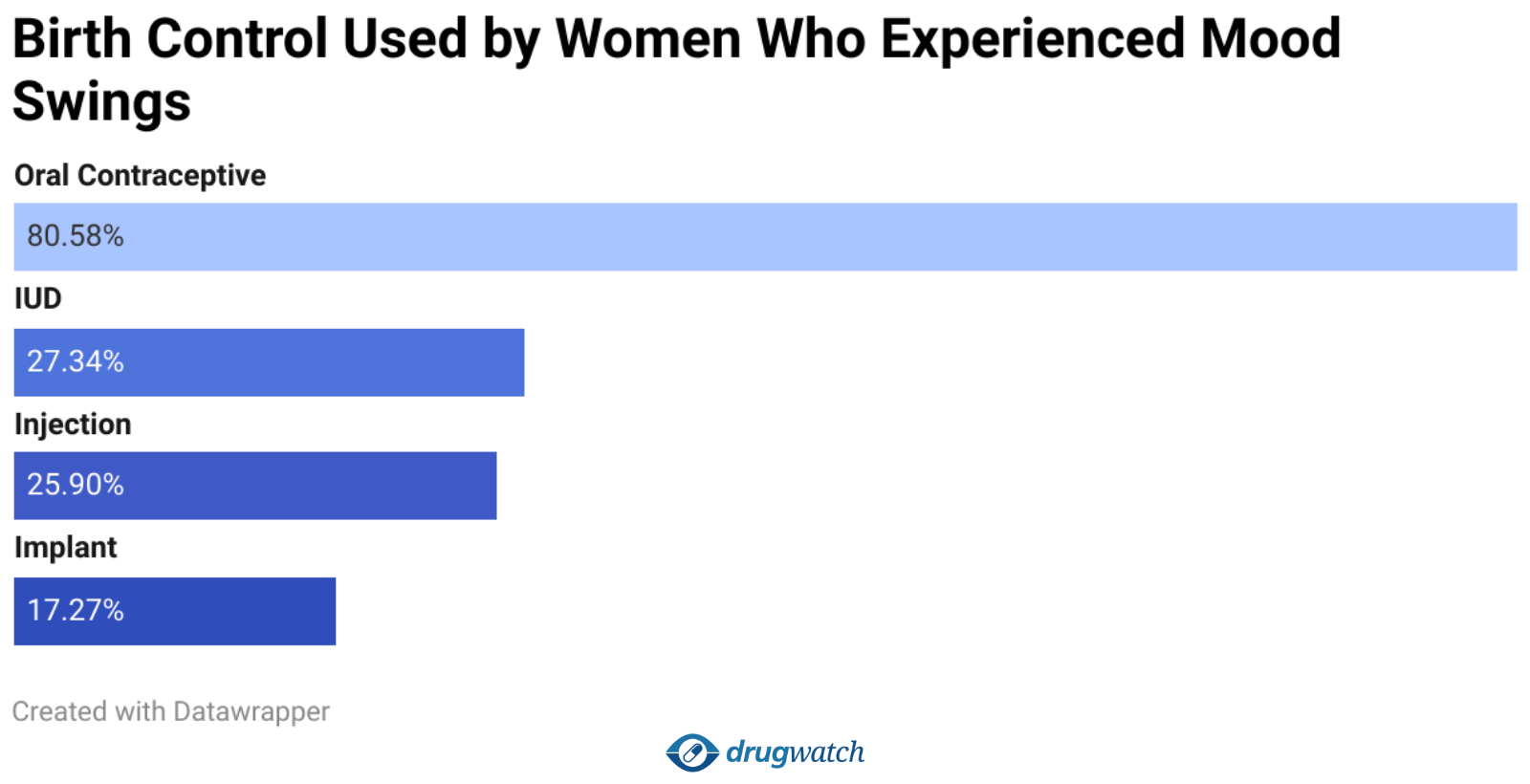
About 80% of respondents who said they experienced mood swings have used the pill at some point. According to Cleveland Clinic, moodiness is an expected side effect while taking the pill.
These changes in mood, along with other more moderate side effects, are typically expected to subside within a few months of use.
Headaches and Migraines
Almost certainly due to its wide-ranging popularity, the birth control pill once again stands out as the most-used option among women who reported that they developed headaches or migraines from their birth control.

“I had severe migraines for five years on the pill. They would last an entire week. They were not regular headaches, but an insane amount of pain that would cause me to vomit. I had to call out of work and it hurt my position.”
Headaches associated with the pill are expected to lessen or go away entirely within a few months.
But there may be additional health concerns regarding migraines. According to the American Migraine Foundation, oral contraceptives can potentially be dangerous for women who already experience migraine.
It could elevate their risk of stroke, cardiovascular disease and blood clots. In some rare cases, headaches can be a symptom of meningioma, a primary brain tumor that has been linked to Depo-Provera.
The Impact of Serious Side Effects
While most side effects reported in the survey were considered minor — or at least not medical emergencies — some women said that they suffered much more serious side effects and injuries as well.
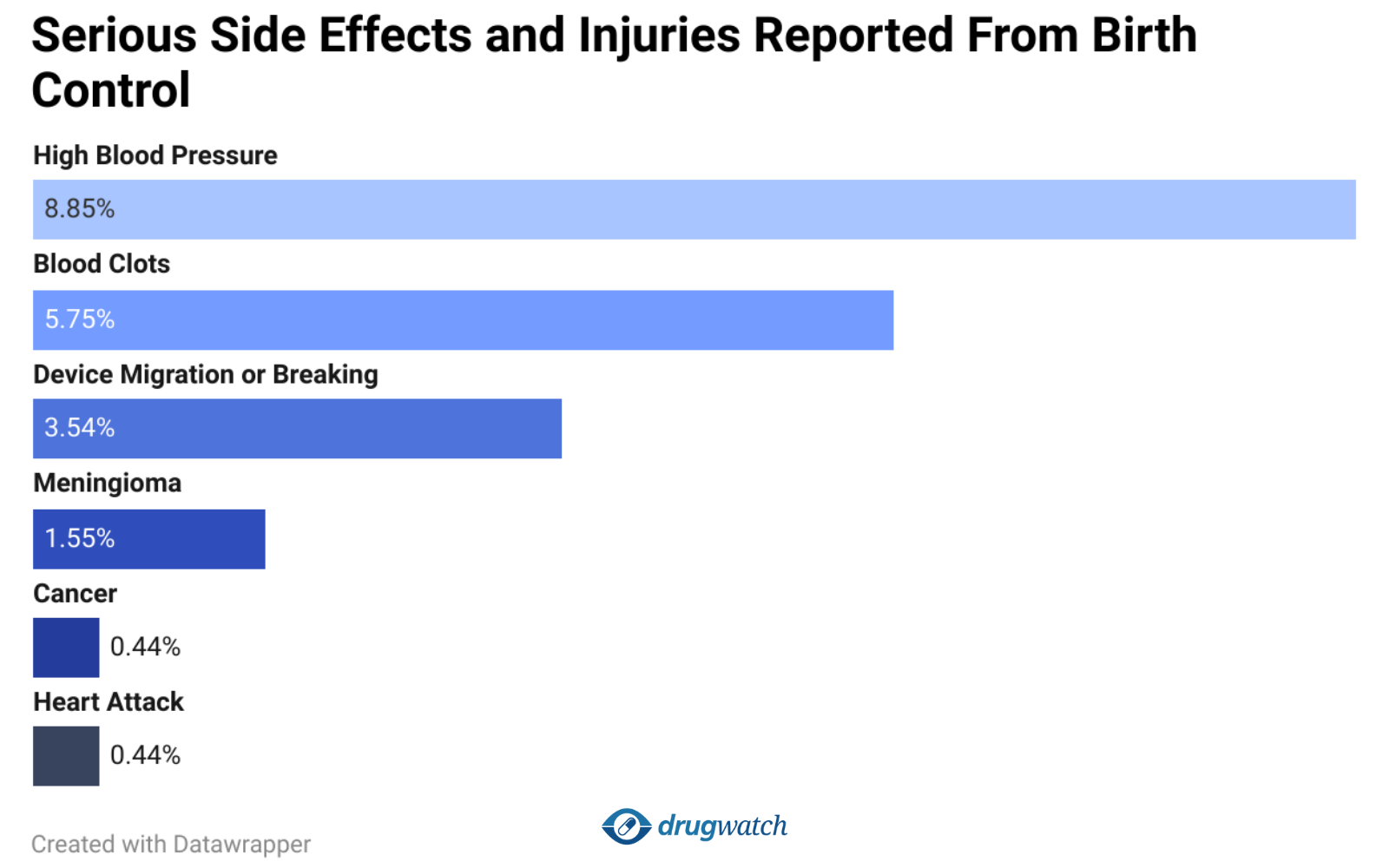
Blood clots are one of the most common serious side effects associated with birth control medications. Oral contraceptives, in particular, have been tied to this condition. Between 2009 and 2018, thousands of lawsuits against popular oral contraceptive brands Yaz and Yasmin were resolved. The lawsuits claimed that the pills led to serious side effects, including blood clots.
If you’ve had blood clots in the past, check with your doctor before taking the birth control pill.
Birth control implants and injections may not be safe for women who have a history of blood clots.
Seven women in the Drugwatch survey say that they developed a meningioma, a type of tumor that forms in the linings of the brain. Recent research has uncovered a potential link between the birth control shot Depo-Provera and the development of these tumors.
A study published in the BMJ found that Depo users could be at upwards of five times higher risk of developing these tumors. Some women who’ve been diagnosed with a meningioma have filed Depo-Provera lawsuits.
“Plaintiffs generally allege that they developed meningiomas — sometimes multiple tumors — after extended use of Depo-Provera,” Brendan Smith, a partner with the law firm Simmons Hanly Conroy, told Drugwatch. “They claim Pfizer did not provide adequate warnings regarding the risk of meningioma.”
Serious side effects listed in the survey are self-reported and could be attributed to other factors like pre-existing conditions, lifestyle or other underlying issues. However, serious side effects should be considered before taking birth control, so speak with your doctor to discuss risk factors before taking any medication.
Birth Control Injection Led to Serious Impacts for Some
Women who say they took birth control injections like Depo-Provera tended to report significant life impacts. Of that group of respondents, more than 53% said that their lives were either severely or greatly impacted by side effects.
This is well ahead of the 35% of women across all types of birth control who answered the same.
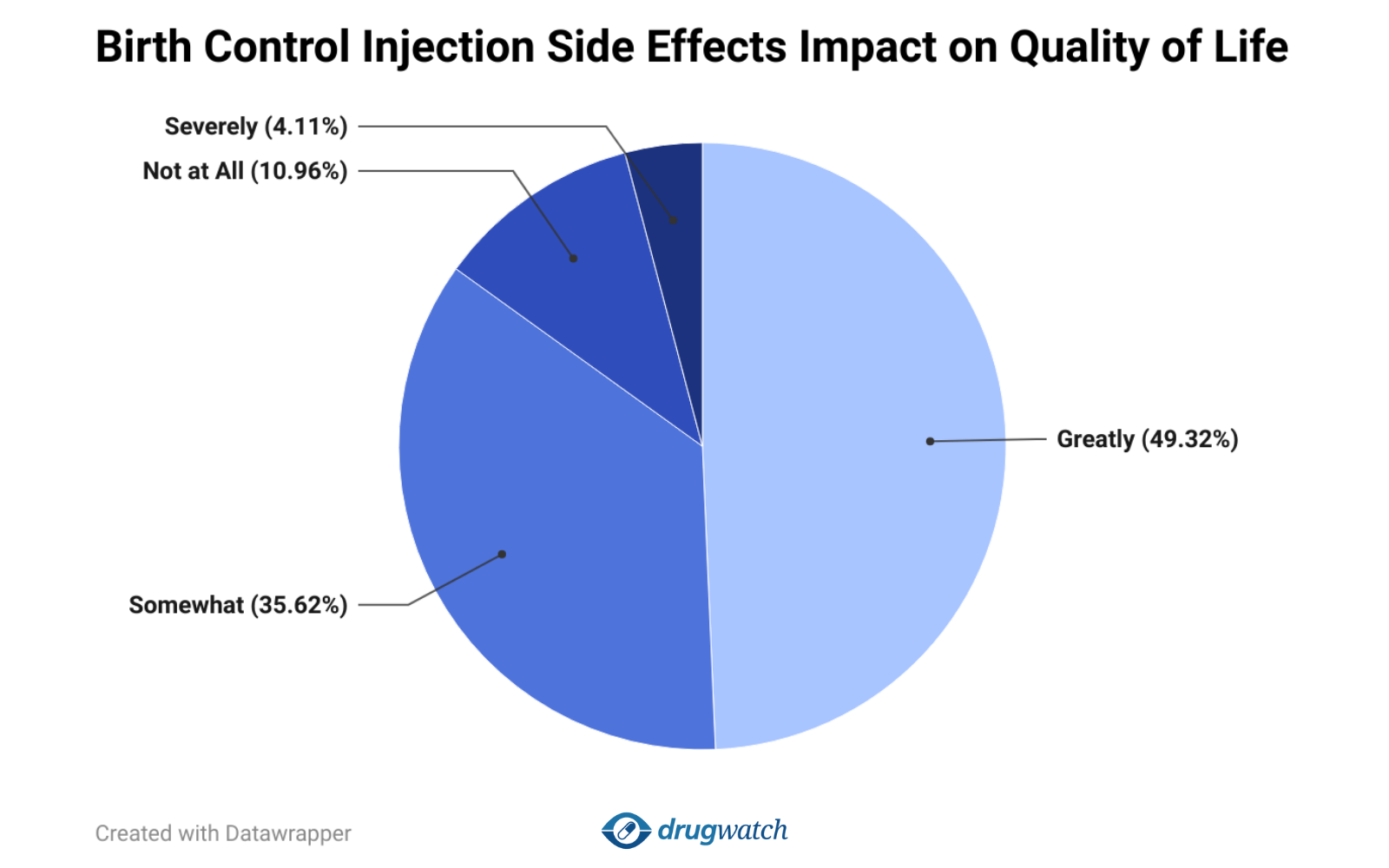
Some women shared their stories on how the hidden costs of Depo-Provera have turned their lives upside down. Tina Thomas, who used Depo-Provera, told Drugwatch that she required multiple invasive surgeries to remove meningiomas. The tumors impacted her hearing and voice.
In addition to emerging concerns over Depo’s ties to meningiomas, the drug also includes a warning for bone density loss and osteoporosis. Those effects may not be reversible even after you stop taking the drug.
Side Effects Are the Main Reason Women Switch Birth Control Methods
Of the 304 respondents who changed birth control methods, 146 say that they did so because of side effects, far outpacing all other reasons.
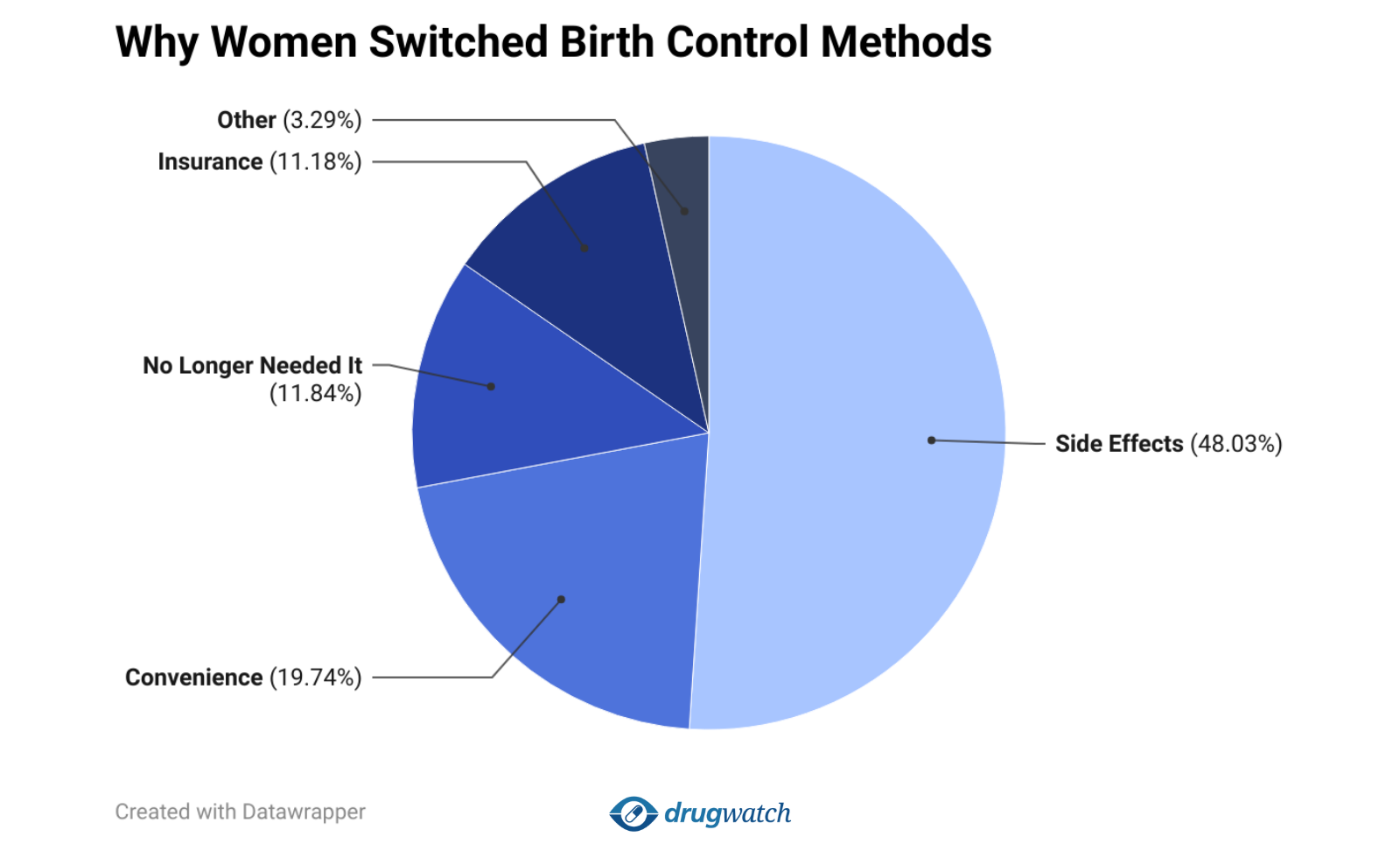
“I switched from the regular pill to the mini pill and it solved all my side effects,” one respondent said.
The second most popular reason was convenience, which 60 respondents said led to a switch. Semipermanent options like IUDs, for example, do not require daily actions like birth control pills. Contraceptive injections are sometimes considered more convenient since they are typically only necessary a few times a year.
“Women live very busy lives and sometimes one thing they don’t want to be worrying about on a daily basis is their contraception,” Dr. Hux said. “They want to have something they can set and forget.”
Some women switched birth control methods simply because their life circumstances changed.
“I used oral contraception in my 20s as well as condoms. As I got older and was sure I wanted to be pregnant, I stopped using them,” one woman said. “After my children were born, I decided on a tubal ligation to prevent any possible future pregnancy.”
It is also not uncommon for women who have switched birth control methods to do so multiple times.
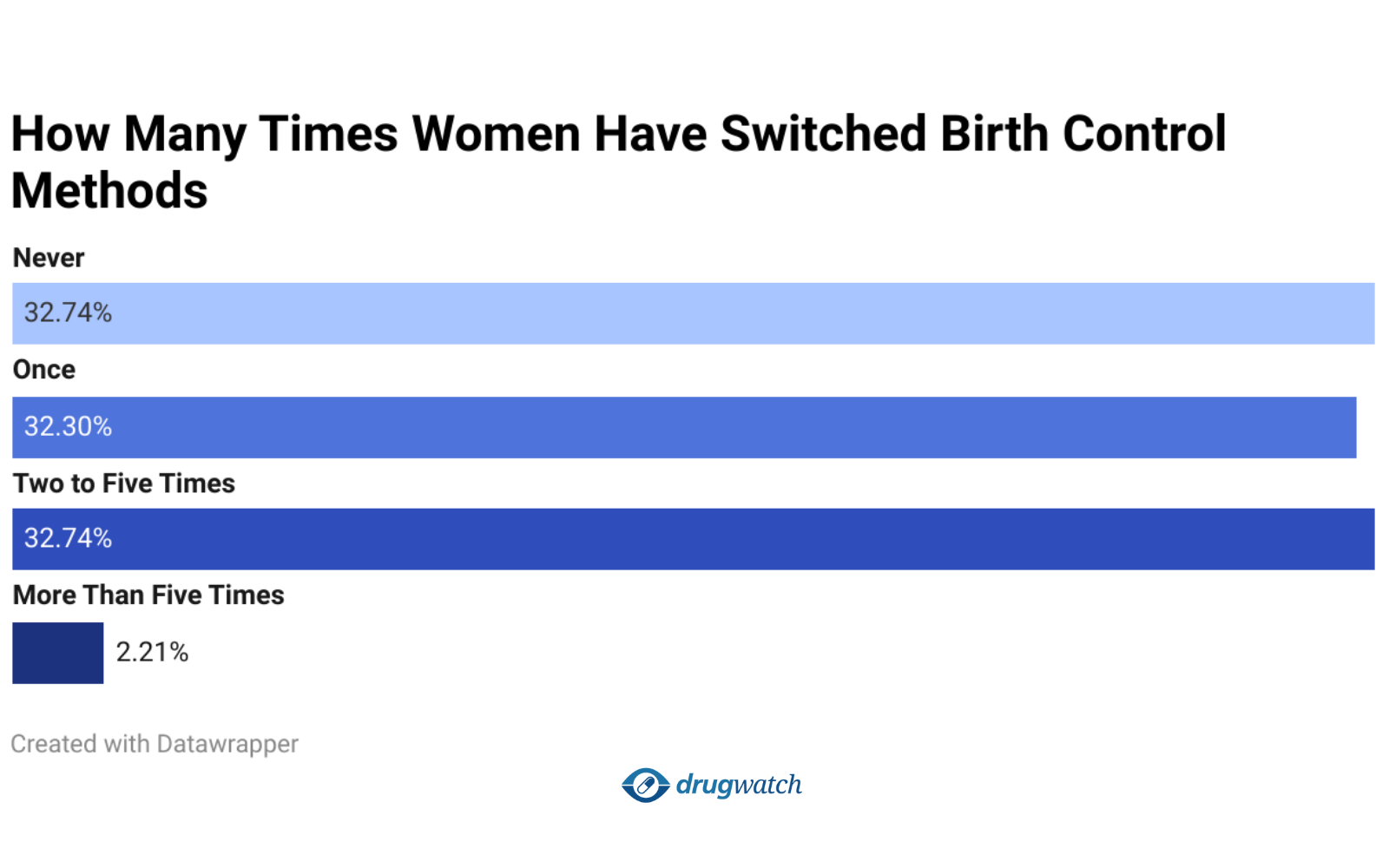
Among 452 respondents who say that they have used birth control, 67% say that they have switched their method at least once.
“It has been an up and downhill battle trying to find the best method for birth control,” one respondent said.
Additionally, 35% of women who used birth control have switched methods twice or more. According to KFF, women use an average of 3.4 different contraceptive methods throughout their lifetime.
About 1 in 5 women also use birth control for a reason other than preventing pregnancy. Some birth control methods may be used to prevent the spread of STIs, to help treat certain medical conditions or to assist in easing certain period symptoms.
While Switching Is Common, Many Women Are Happy With Their Current Option
While it may take multiple tries to land on a birth control option that makes sense, survey respondents tend to be satisfied with their method of choice once they find it.
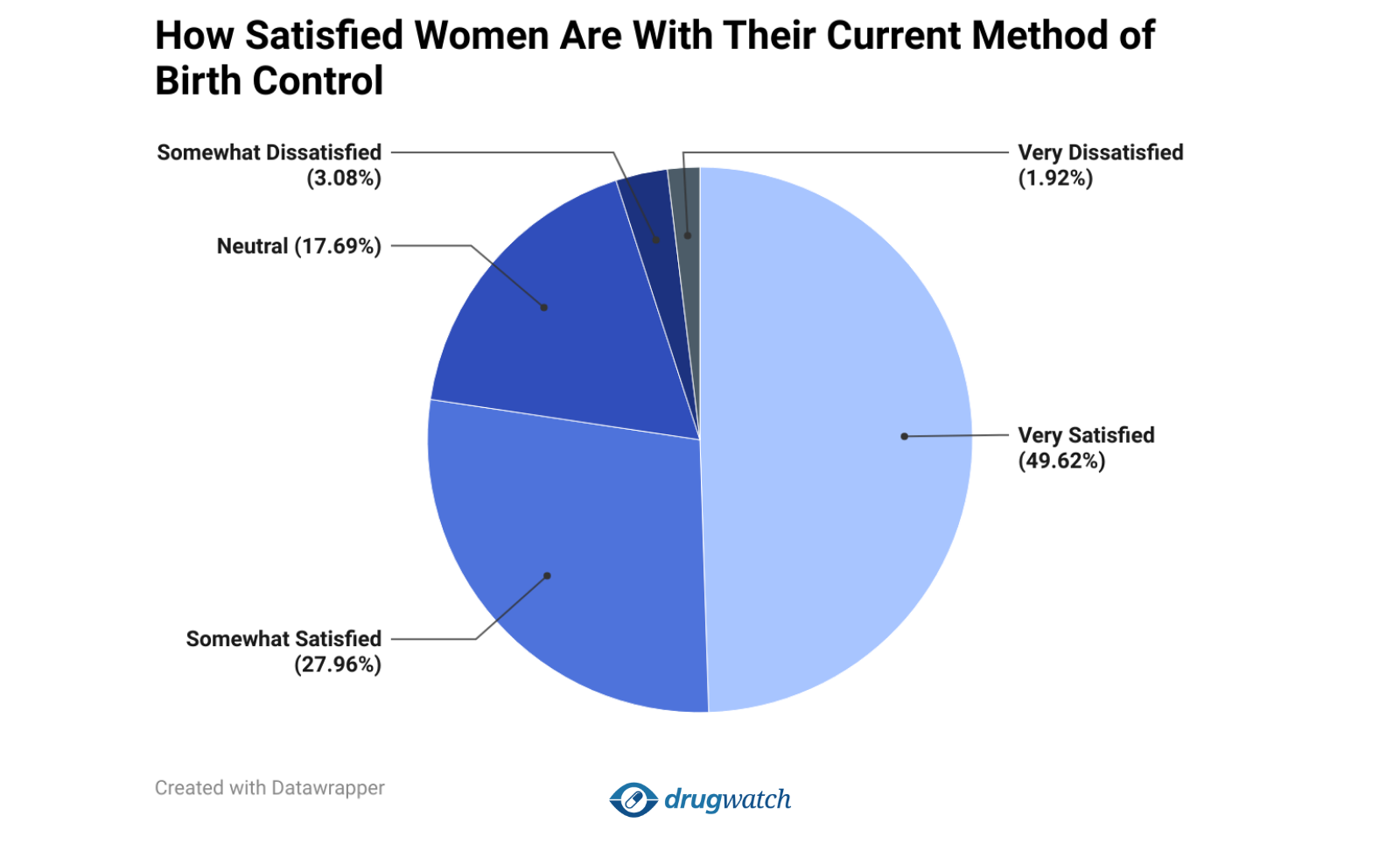
An overwhelming 77% of women surveyed reported being at least somewhat satisfied with their current birth control method. Only 5% of women reported any level of dissatisfaction.
While many women may experience side effects or injuries as a result of birth control, most are either able to switch to an option that makes sense for them, or the side effects they experience are not serious enough to lower their satisfaction.
Despite the Side Effects, Birth Control Options Provide Many Benefits
Many women who took part in Drugwatch’s survey gave information on how side effects from birth control had impacted their lives. These ranged from what could be considered minor and expected side effects, such as mood shifts or weight changes, to far more serious issues.
Despite those concerns, women were overwhelmingly satisfied with their current birth control option. Of the more than 250 women surveyed who were currently using birth control, only 13 expressed any level of dissatisfaction with their current method.
The advent of new types of birth control in recent decades has also led to expanded choice for women, helping them to find an option that makes sense even if their first choice didn’t work for them.
“If someone doesn’t desire to be pregnant, there are so many ways to prevent that,” Dr. Hux said. “We just have to find the right way for the patient.”
Calling this number connects you with a Drugwatch.com representative. We will direct you to one of our trusted legal partners for a free case review.
Drugwatch.com's trusted legal partners support the organization's mission to keep people safe from dangerous drugs and medical devices. For more information, visit our partners page.



